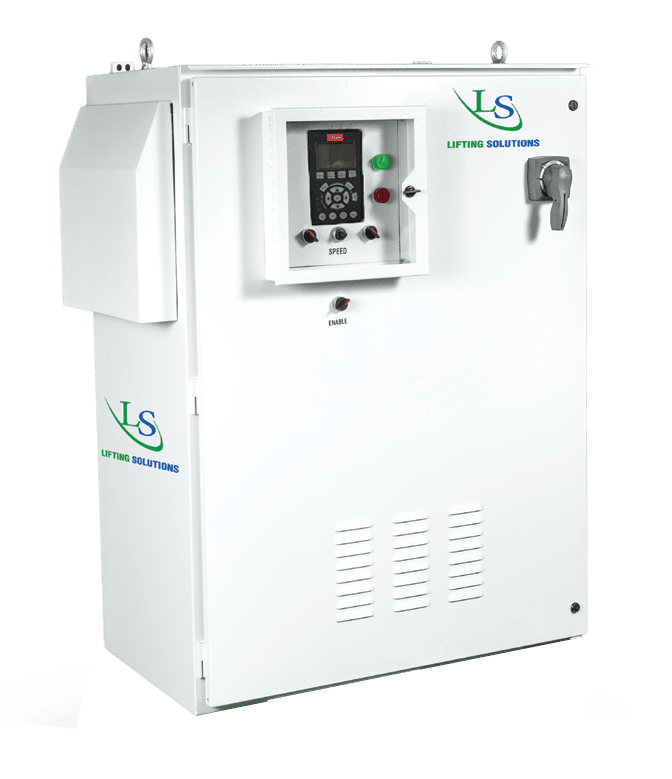EnerSaver® 2.0 Drive System
Provides enhanced motor speed and torque control to optimize wells.

CONTROL and enhance pc pump and PUMPJACK applications
The EnerSaver 2.0 progressing cavity pump and pumpjack variable frequency drive (VFD) package offered by Lifting Solutions provides enhanced motor speed and torque control to optimize wells.
The system is designed with cost, ease of installation, and field operator convenience in mind. The base unit is user-friendly and features a clean interface for efficient setup and operation. The modular design allows customers to install a basic unit and add options based on operator requirements. The user interface consists of a simple local keypad and display for managing setpoints, with an RPM dial for speed control. Additionally, an optional full-color touchscreen HMI is available for a more intuitive user experience.
How our EnerSaver 2.0 Drive System works
The Lifting Solutions EnerSaver 2.0 Drive System is North America’s only inverter in the artificial lift market that is certified to UL 1741 (CSA 22.2 107.1) standards. What does that mean? As a micro-generator, the system must meet strict utility grid interconnection performance requirements, such as anti-islanding, power quality, interconnection integrity, and specific operating voltage to be allowed to connect to the utility grid. The EnerSaver drive system meets these requirements making it the ideal system to optimize oil production and support OPEX and CAPEX reductions.
Features
- Carbon credit eligible
- Average annual power cost savings of greater than 28%
- Increases drive efficiency by approximately 30%
- Generates reactive power
- Unity power factor
- No braking resistance
- One-year standard warranty
Application Considerations
When determining whether the EnerSaver 2.0 Drive System will work for you, consider the following, or get in touch with our automation and optimization engineers.
-
- Minimum 10,000 kWh/month
- Review monthly usage (kWh), peak demand readings, and penalty charges
-
- Minimum 40 hp motor (based on a minimum of 42 amps and running 95% of the time)
- Electric motor must be rated for VFD use
-
- Minimum 42 amps continuous operation
- Higher amps result in larger consumption and higher savings
- To determine peak amps on each phase, measure with a clamp meter at the motor junction box
-
- Is the unit controlled by a POC?
- How many hours per day is the POC running?
- Is the POC timed or “smart”?
- How many strokes per minute is the pump jack running? (A higher runtime and number of strokes per minute results in larger consumption and higher savings)
-
- Minimum 25 kW/kVA
- Demand or wires charges can be up to 50%–70% of total bill
- Higher demand usually results in higher savings
-
- Does the wellsite have capacity issues (e.g. the utility can’t supply the required peak load)?
- The EnerSaver Multi-Well Drive System can reduce demand charges on new well locations, which increases the capacity of the electric grid
- A real-place example was with a Lifting Solutions client. They were told by the utility company that capacity would only permit the install of three pump jacks. With the installation of the EnerSaver Multi-Well Drive System, the client was able to install 4 pumping units instead of 3, helping to maximize production.
-
The EnerSaver Multi-Well Drive System is not a candidate for single-phase power supply or on a Floating Ground Delta configuration
-
Are power factor penalties present?
Some utility companies charge penalties for power factors less than 0.90. A Lifting Solutions automation client was paying over $150/month in penalties. With the EnerSaver Multi-Well Drive System, penalties were eliminated thanks to the perfect Power Factor (PF=1).
-
Electric utilities charge penalties for excessive harmonics; or they may require the customer to pay to correct poor harmonics. The EnerSaver Multi-Well Drive System minimizes the number of harmonics introduced to the grid, which eliminates penalty charges. On top of that, the incremental cost of the generative drive is, normally, less than the cost of a harmonic filter.
Let’s optimize your well.
Connect with our client solutions team and Experience Performance.